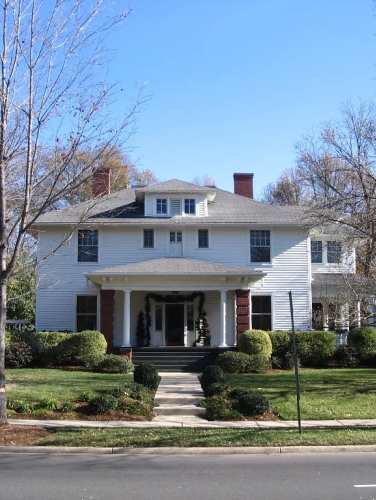
Bishop John C. Kilgo House
(ca. 1914)
The Louis H. Asbury-designed home of a respected Methodist bishop and president of Trinity College
2100 The Plaza, Charlotte, NC 28205
Built in 1914, the Bishop John Carlisle Kilgo House was among the first and finest residences in the Chatham Estates suburb, now known as Plaza-Midwood. Kilgo (1861-1922), a distinguished Methodist minister, served as president of Trinity College (later Duke University) between 1894 and 1910. Appointed bishop of the Methodist Episcopal Church, South in 1910, Kilgo moved with his wife Fannie and their five children to Charlotte in 1915, when they took up residence as the original owners of this house. The house, combining both Colonial Revival and Craftsman-style elements, is also notable as the work of Louis H. Asbury, one of Charlotte’s foremost architects in the early twentieth century.
Property Quick Links
Born in Laurens, South Carolina, the son of a Methodist preacher, Kilgo attended Gaffney Seminary and Wofford College in Spartanburg. After a period as a Methodist minister in the South Carolina Conference, he taught philosophy and served as an administrator at Wofford College until 1894 when he became president of Trinity College. During his Trinity tenure, Kilgo helped transform the college from a small, modestly funded institution into one of the best known and most richly endowed universities in the South. He initiated the construction of Trinity’s first women’s dormitory, leading to the creation of a coordinate college for women, and actively encouraged freedom of speech among faculty and guests. Upon Kilgo’s invitation, African American leader Booker T. Washington gave his first speech at a southern white college. As a Methodist bishop, Kilgo gained a reputation as a gifted orator and was recognized as one of the great preachers of his day. A member of the church’s Education Commission, Kilgo was instrumental in the founding of Atlanta’s Emory College, for which he served as a trustee and lecturer. Kilgo also served on the board of directors for the Southern Railway. Charlotte’s Kilgo United Methodist Church, located east of the Kilgo House on Belvedere Avenue in Plaza-Midwood, was named in the bishop’s honor. Following his 1922 death at age sixty-one, his widow Fannie continued to live in the house until her death in 1948.
Louis Humbert Asbury (1877-1975), one of North Carolina’s first professionally trained architects and one of the region’s foremost building designers of the early twentieth century, designed the Bishop Kilgo House. A Charlotte native, Asbury studied architecture at the Massachusetts Institute of Technology before returning to his hometown to open his firm in 1908. As the first North Carolina member of the American Institute of Architects, Asbury earned hundreds of commissions in Charlotte and the surrounding counties. His notable body of work includes the 1926 Mecklenburg County Courthouse, the 1929 Mayfair Manor (renamed Dunhill Hotel), the 1927 First National Bank skyscraper on South Tryon Street, the 1918 Old Mount Carmel Baptist Church building, and the 1928 Myers Park Methodist Church building, as well as numerous stately homes throughout Charlotte.

